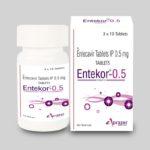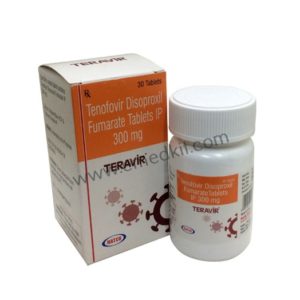Description
Entekor 0.5mg.
WARNING: SEVERE ACUTE EXAGERBATIONS OF HEPATITIS B.PATIENT CO-INFECTED WITH HIV
AND HBV and LACTIC ACIDOSIS AND HEPATOMEGALY.
Severe acute exacerbations of hepatitis B have been reported in patients who have discontinued
Anti-hepatitis B therapy, including entecavir.Hepatic function should be monitored closely with both
Clinical and laboratory follow-up for at least several months in patients who discontinue anti-hepatitis
B therapy.If appropriate.initiation of anti-hepatitis B therapy may be warranted[see WARNINGS AND PRECAUTIONS].
Limited clinical experience suggests there is a potential for the development of resistance to HIV
(human immunodeficiency virus.) nucleoside reverse transcriptase inhibitors if ENTEKOR is used to
Treat chronic hepatitis B virus (HBV) infection in patients with HIV infection that is not being treated.
Therapy with ENTEKOR is not recommended for HIV/HBV co-infected patients who are not also
Receiving highly active antiretroviral therapy(HAART)[see WARNING AND PRECAUTIONS].
Lactic acidosis and severe hepatomegaly with steatosis, including fatal cases, have been reported with
The use of nucleoside analogs alone or in combination with antiretroviral [see WARNING AND PRECAUTIONS].
COMPOSITION
ENTECAVIR 0.5 mg
Each film-coated tablet contains.
Entecavir IP…………………………………………………………….0.5mg
Colour: Titanium Dioxide IP & Red Oxide of Iron
DOSAGE FROM
Oral film-coated tablet
PHARMACOLOGY
Pharmacodynamics
Mechannism of action
Entecavir is an antiviral drug.Entecavir a gaunosine nucleoside analogue with activity against HBV reverse transriptase (rt).is efficiently phosphorylated to the active triphosphate form which has
an intracellular half-life functionally inhibits all three activities of the HBV reserve transcriptase:
Base priming.(2) reverse transcnption of the negative stand from the pregenomic messenger
RNA and (3) synthesis of the positive stand of HBV DNA Entecavir inphosphate is a weak inhibitor
Of cellular DNA polymerases α β and δ and mitochondrial DNA polymerase gamma with K,values
Raning from 18 to<160 Γm .Antiviral Activity.Entecavir inhibited HBV DNA synthesis(50% Reduction,EC) at a concentration of 0.004 ΓM in human HepG2 cells transfected with wild-type HBV.The median EC value for entecavir against lamivudine-resistant HBV (rtl 180M,Tm204v) Was 0.026 ΓM.(range 0.010 to 0.059 ΓM) The co-administration of HIV nucleoside/ nucleotide Reverse transcriptase inhibitors (NRTIs) wlth entecavir is unlikely to reduce the antiviral efficacy Of entecavir against HBV or of any of these agents against HIV,in HBV combination assays in cell culture,abacavir,didanosine,lamivudine,stavudine,tenfovir or zidovudine were not antagonistic to the cell culture anti-HIV activity of these six NRTIs or emtricitabine at concentrations grater than 100 time C max of entecavir using 1 mg dose. Antiviral Activity against HIV Analysis of the inhibitory activity of entecavir against a panel of laboratory and clinical HIV type 1(HIV-1) isolates using a variety of cells and assay conditions yielded EC50 values ranging from 0.026 to >10 ΓM; the lower EC50 values were observed when decreased levels of virus were
Used in the assay.in cell culture entecavir selected for an M1841 substitution in HIV variants
Containing the M184V substitution showed loss of susceptibility to entecavir.
Pharmacokinetics.
The single- and multiple-dose pharmacokinetics of entecavir were evaluated in healthy subjects
And subjects with chronic HBV infection. Absorption.following oral administration in healthy
Subjects, entecavir peak plasma concentration occurred between 0.5 and 1.5 hours.following
Multiple daily doses ranging from 0.1to 1.0 mg.CMAX and area under the concentration-time curve (AUC) at steady state increased in proportion to dose.Steady state was achieved after 6 to 10 days of once-daily administration with approximately 2-fold accumulation.for a 0.5 mg oral
Dose, CMAX at steady state was 4.2ng/ML.and trough plasma concentration (C1rough) was 0.3 ng/ML.for a 1mg oral dose. CMAX at steady state was 4.2ng/ML and trough plasma concentration( CMAX ) was 0.3 ng/ml for a 1 mg oral dose CMAX was 8.2ng/ml and C1rough was 0.5ng.ml.Effects of Food on Oral Absorption: Oral administration of 0.5 mg of entecavir with a
Standard high-fat meal (945 kcal,54.6 g fat)or a light meal(379 kcal.8.2 g fat) resulted in a delay
In absorption (1.0-1.5 hours fed versus 0.75 hours fasted).a decrease in AUC of 18-20%[see DOSAGE ANDADMINISTRATION].
Distribution.
Based on the pharmacokinetic profile of entecavir after oral dosing, the estimated apparent volume of distribution is in excess of total body water, suggesting that entecavir is extensively
Distributed into tissues.Binding of entecavir to human serum proteins in vitro was approximate
13%.
Metabolism and Elimanation.
Following administration of 14C-entecavir in humans and rats, no oxidative of acetylated metabolism were observed.minor amounts of phase II metabolites (glucuronide and sulfate
Conjugates ) were observed entecavir is not a substrate, inhibitor, or includer of the cytochrome
P450(CYP450) enzyme system [see Drug Interactions].
After reaching peak concentration entecavir plasma concentrations decreased in a bi-exponential manner with a terminal elimination half-life of approximately 128-149 hours.the observed drug accumulation index is approximately 2-fold with once-daily dosing.suggesting an
Effective accumulation half-life of approximately 24 hours.
Entecavir is predominantly eliminated by the kidney,with unary recovery of the unchanged drug
At steady state ranging from 62% to 73% of the administered dose.Renal clearance is independent of dose and ranges from 360 to 471 ml/min,suggesting that entecavir undergoes both glomerular filtration and net tubular secretion [see Drug Interactions.]
Special Populations
Gender: there are no significant gender differences in entecavir pharmacokinetic.
Race:There no significant racial differences in entecavir pharmacokinetic.
Elderly: the effect of age on the pharmacokinetic of entecavir was evaluated following administration of a single 1 mg oral dose in healthy young and elderly volunteers. Entecavir AUC was 29.3% greater in elderly subjects compared to young subjects. The disparity in exposure between elderly and young subjects was most likely attributable to differences in renal function.Dosage adjustment of ENTEKOR Tablets should be based on the renal function of the patient,rather than age [see DOSAGE AND ADMINISTRATION].
Pediatrics : pharmacokinetic studies have not been conducted in children.
Renal impairment: the pharmacokinetic of entecavir following a single 1mg dose were studied in subjects(without chronic HBV infection) with selected degrees of renal impairment.including subjects whose renal impairment was managed by hemodialysis or continuous ambulatory peritoneal dialysis (CAPD).Results are shown in Table 1 [see DOSAGE AND ADMINISTRATION].
Table 1: Pharmacokinetic Parameters in Subjects with Selected Degrees of Renal function
Renal Function Group
Baseline Creatinine Clearance (ml/min)
Unimpaired Mild Moderate Severe Severe Severe
>80 >50 to 30 to 50 <30 managed Managed
n=6 <-80 n=6 n=6 with with n=6 hemodialysis CAPD n=6 n=4
Cmax (ng/ml) 8.1 10.4 10.5 15.3 15.4 16.6
(CV%) (30.7) (37.2) (22.7) (33.8) (56.4) (29.7)
AUC(0-T) 27.09 51.5 69.5 145.7 233.9 221.8
(ng*/ml) (25.6) (22.8) (22.7) (31.5) (28.4) (11.6)
CLR 383.2 197.9 135.6 40.03 NA NA
(ML/MIN) (101.8) (78.01) (31.6) (10.1)
(SD)
CLT/F 588.1 309.2 226.3 100.6 50.6 35.7
(ML//MIN)(SD) (153.7) (62.6) (60.1) (29.01) (16.5) ( 19.6)
*Dosed immediately following hemodialysis.
CLR = Renal clearance: CLT/F= Apparent oral clearance.
Following a single 1 mg dose of entecavir administered 2 hours before the hemodialysis.session. hemodialysis.removed approximate 13% of the entecavir dose over 4 hours. CAPD removed approximately 0.3% of the dose over 7 days (see DOSAGE AND ADMINISTRATION). Hepatic impairment. The pharmacokinetics of entecavir following single 1 mg dose was studies in subjects (without chronic HBV infection).with moderate os severe hepatic impairment (child-pugh class B or C).The pharmacokinetics of entecavir was similar between hepatically impairment and healthy control subjects: therefore. No dosage adjustment of ENTEKOR Tablets is recommended for patients with hepatic impairment. Post-liver Transplant: the safety and efficacy of ENTEKOR tablets in liver transplant recipients are unknown, however in a small pilot study of entecavir use in HBV-infected liver transplant recipients on a stable dose of cyclosporine A (n=5) or tacrolimus (n=4) entecavir exposure was approximately 2 fold the exposure in healthy subjects.The potential for pharmacokinetic interactions between entecavir and cyclosporine A or tacrolimus was not formally evaluated.















Reviews
There are no reviews yet.